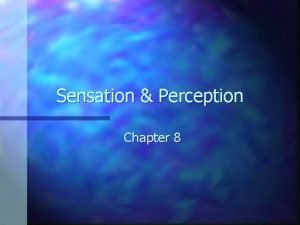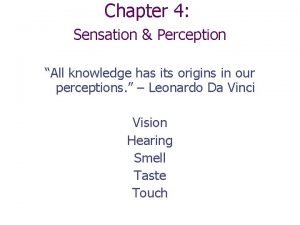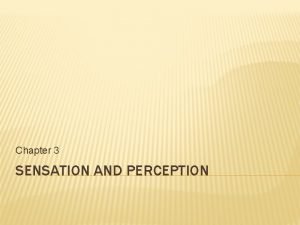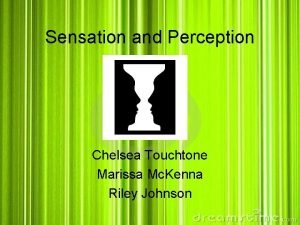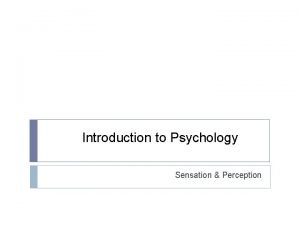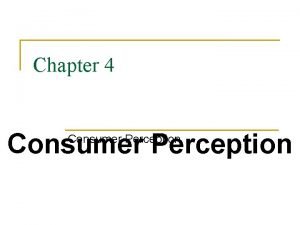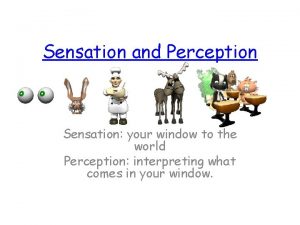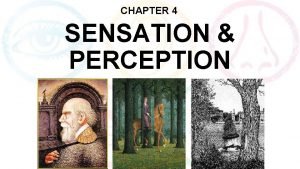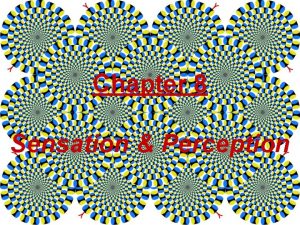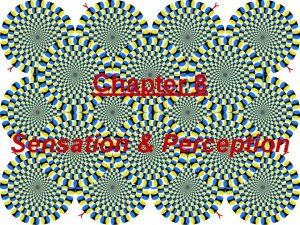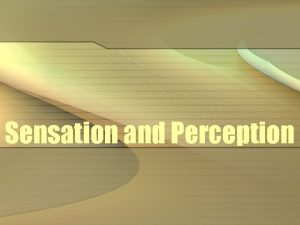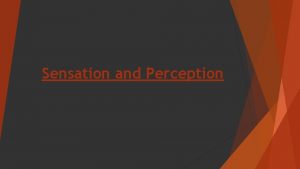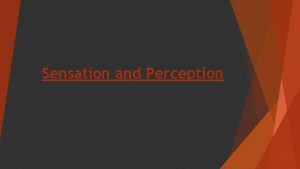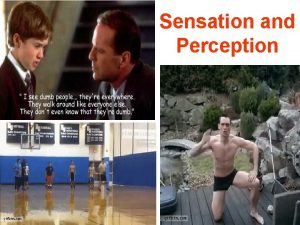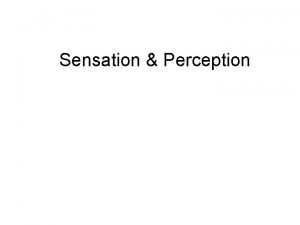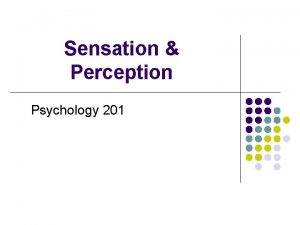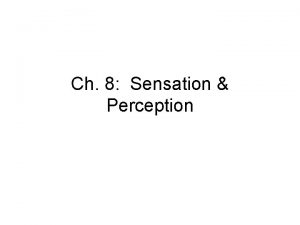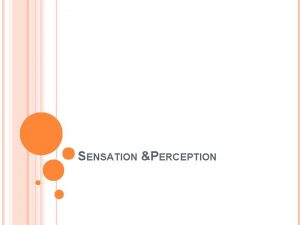Sensation and Perception Chapter 3 Psychophysics This is














- Slides: 14

Sensation and Perception Chapter 3

Psychophysics • This is how we experience our physical world. • Classroom demo judging weight of pill bottles. • Which one do you think weighs the most? • The more compact weight “felt” heavier to your brain when in reality it weighed the same as the large container.

Sensation • The process by which our sensory systems (eyes, ears, and other sensory organs) and nervous system receive stimuli/info from the environment • A person’s awareness of the world through their senses.

Sensation uses Bottom-Up Processing • Information processing that focuses on the raw material entering through the eyes, ears, and other organs of sensation

Perception • The process of selecting, organizing and interpreting sensory information • How you make sense of your sensory information.

Perception uses Top-Down Processing • Information processing that focuses on expectations and experiences in interpreting incoming sensory information

Read the following • Aoccdrnig to rscheearch at Cmabrigde Uinervtisy, it deosn’t mttaer in waht oredr the ltteers in a wrod are, the olny iprmoetnt tihng is taht the frist and lsat ltteer be at the rghit pclae. The rset can be a total mses and you can sitll raed it wouthit a porbelm. Tihs is bcuseae the huamn mnid deos not raed ervey lteter by istlef, but the wrod as a wlohe.


Bottom-Up vs. Top-Down Processing Follow the directions carefully! • Go to http: //jeffmilner. com/backmasking. htm. Pick a song from the list and listen to it normally (play forward). • Now listen to it in reverse. DO NOT CLICK ON “SHOW REVERSE LYRICS” • Now listen to it in reverse again, this time “Show the Reverse Lyrics” • Can you hear the “secret” message? • Why couldn’t you hear it the first time you listened in reverse? – You had no expectations. Just heard sounds. This is Bottom-Up processing! • Why could you make out the “hidden message” when you could see the reverse lyrics? – When told what to listen for the task becomes Top. Down processing! You are using your expectations!

Do subliminal messages work? • Subliminal messages make two assumptions: 1. We can unconsciously sense the subliminal (below threshold) message. - TRUE 2. Without our awareness, the stimuli have suggestive powers. - FALSE • Subliminal messages can affect how we “feel” about something for a short period of time but CANNOT persuade us to actually go out and do something. • Remember, weak stimuli have weak responses and strong stimuli have strong responses. • Extra credit to anyone who can make a coherent song that when played backwards says, “I love psychology!”

I Love Psych!!!

Did it work? • Do you really love psychology now? • It was worth a try!

Principles of Sensation • Transduction— process where physical energy is converted into neural signals • How we convert stimuli from the environment into action potential that the brain can understand.

The Major Senses • There are 6 major senses – – – vision hearing touch taste pain smell • The list can be extended with balance, joint senses and others • Vision has been studied most extensively
 Chapter 5 sensation and perception
Chapter 5 sensation and perception Chapter 3 sensation and perception
Chapter 3 sensation and perception Chapter 6 sensation and perception
Chapter 6 sensation and perception Chapter 4 sensation and perception test
Chapter 4 sensation and perception test Chapter 6 sensation and perception
Chapter 6 sensation and perception Sensation perception
Sensation perception Chapter 4 sensation and perception
Chapter 4 sensation and perception Chapter 3 sensation and perception
Chapter 3 sensation and perception Reversible figure gestalt
Reversible figure gestalt Perceptual set ap psych
Perceptual set ap psych Types of perception
Types of perception Sensation and perception crossword review answers
Sensation and perception crossword review answers Sensation and perception
Sensation and perception Pecetion
Pecetion Sensation and perception
Sensation and perception





